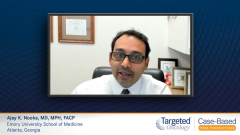
Dara-RVd in NDMM: Updates from the GRIFFIN Study
Expert perspectives on the use of daratumumab with RVd in patients with newly diagnosed multiple myeloma in the context of updates from the GRIFFIN study.
Episodes in this series

Transcript:
Ajay K. Nooka, MD, MPH, FACP: [the] GRIFFIN trial is the first randomized phase 2 trial reflecting the practice patterns in the United States where the standard of care arm is the lenalidomide [Revlimid], bortezomib [Velcade], dexamethasone, or the RVd arm.
So patients would be randomized to receive RVd, or addition of daratumumab [Darzalex] to this backbone, daratumumab plus RVd, and patients would receive 4 cycles first, followed by a transplant, followed by 2 further cycles of consolidation.
The daratumumab arm would get daratumumab plus RVd as consolidation. RVd arm would get RVd as consolidation for 2 further cycles. The primary end point for this trial is the stringent complete response after the consolidation. Patients would essentially receive a total of 6 cycles of induction plus consolidation therapies.
What we were seeing is the stringent complete response rates are close to 32% at the end of consolidation and the GRIFFIN trial. For the RVd arm, what the additional daratumumab [does], in this context, is the response rates, the stringent complete response rates, increased to 42% with the addition of daratumumab.
So those results again were published in Blood. Pete Voorhees [Levine Cancer Institute, Charlotte, North Carolina] was the senior author. And these are very important results because when we are talking about the depth of response post-transplant to be a measure of long-term success, and clearly daratumumab plus RVd has provided us that depth of response.
Now, this brings us to the context of what Jacob Laubach [Dana-Farber Cancer Institute and Brigham and Women’s Hospital, Boston, Massachusetts] had presented at ASH [American Society of Hematology] meeting] of 2021. As the patients continue to receive the maintenance with daratumumab plus lenalidomide in the daratumumab arm versus lenalidomide in the RVd arm, what happened at the 24-month mark?
These responses tend to continue to deepen and deepen. And at 24 months, the stringent complete response rates in the daratumumab arm were 66%, which is 2 of the 3 patients achieved the stringent complete response. So, the same numbers, if you look for the RVd arm, these numbers were 48%.
Now taking this step further, if you look at the MRD [minimal residual disease] negative rates, these are significantly higher again, and both at 10−5 and 10−6, favoring the daratumumab combination.
Another step that was presented in Jacob [Laubach’s] presentation was can you sustain these MRD negative rates at the 6-month mark and the 12-month mark in both the daratumumab arm as well as the RVd arm?
And clearly, the daratumumab arm has shown the benefit. Again, in the sustaining of these MRD responses and 44% of the patients at the 12-month mark are 10−5, compared to a third, which is close to 15% in the RVd arm.
So not only the daratumumab arm has resulted in deeper responses, [but] it was [also] able to sustain those responses. And clearly, the PFS [progression-free survival] benefit at 89%. A 3-year PFS benefit was 89% in the daratumumab arm versus 81% in the RVd arm.
In other words, 19% of the patients have progressed on the RVd arm and 11% of the patients had progressed at the 3-year mark in the daratumumab arm. This is showing signs of initial success.
So overall survival benefits, you don’t find them at this point clearly for the same reasons that I discussed earlier, that the follow-up is too sharp. The longer that we follow, we tend to see these benefits over the long run.
Transcript edited for clarity.









































